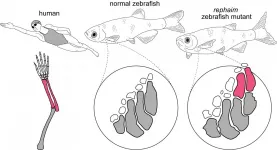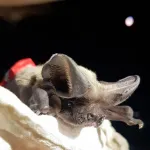(Press-News.org) By tweaking a single gene, Harvard scientists engineered zebrafish that show the beginning formation of limb-like appendages. The researchers stumbled upon this mutation, which may shed light on the sea-to-land transition of vertebrates, while screening for various gene mutants and their impact on fish development. Their discovery, outlined February 4th in the journal Cell, marks a fundamental step in our understanding of fin-to-limb evolution and how surprisingly simple genetic changes can create great leaps in the development of complex structures.
"It was a little bit unbelievable that just one mutation was able to create completely new bones and joints," says M. Brent Hawkins (@Homeobox), first author of the study, who recently received his doctorate from Harvard Organismic and Evolutionary Biology. "In the 30,000 species of teleost fishes, none of them have this sort of variation, so the fact that we found a mutant like this really knocked us off our feet."
The mutation Hawkins and colleagues discovered causes a change in in the zebrafish's pectoral fin bones called "proximal radials," which attach to the fish shoulder joint, similar to how the human arm attaches to our shoulder. But unlike humans and other tetrapods, zebrafish do not have series of these skeletal elements that articulate at joints, such as the components of our arm and fingers. With this mutation, a new set of long bones called "intermediate radials" develop and are able to articulate with the existing proximal radials, making a joint similar to our elbow.
"In this one mutation, you get the new bone, you make the joint, and you make the muscle attachments all in one go," says senior author Matthew Harris (@fishyskeleton), an associate professor of Genetics at Harvard Medical School and Orthopedics at Boston Children's Hospital. "You didn't need to have a mutation in the muscle gene, a joint gene, and in the bone gene; the system is coordinated such that whatever our change is, it's able to push all these things together in unison."
Genetic analysis revealed that mutations in either of two genes, vav2 and waslb, can independently cause this developmental change. Neither gene has previously been connected to skeletal development, but the analysis revealed that both genes activate Hox programs that pattern the middle region of the limb. "With these zebrafish, we're able to actually show that these mutations are activating programs that are quintessentially thought to be only found in a limb," says Harris. "So not only do we have the phenotype of something never before seen in teleost fish, but we show we can turn on ancestral patterns that were thought to be only limb associated."
Limbs are thought to be a key evolutionary innovation, allowing vertebrates to walk on land and--in the case of birds and bats--fly. What these results show is that a group of fishes who were thought to have either lost or silenced the machinery necessary to evolve limb-like appendages actually retain an innate latency to form these structures. "With our work, we've found unexpected commonalities between fins and limbs, and I think there are even more similarities that are yet to be discovered," says Hawkins.
Despite these findings, a question still remains of whether these new bones change the functionality of the zebrafish pectoral fins. Next steps will incorporate fine-scale video microscopy to determine whether the articulation of these news bones is enough to influence how the fish move. "Normally, the structures are not present to allow for the articulation required for movement on land," says Harris. "It'd be very interesting to see, for example, if we put our mutant on a platform, whether they would have an adjusted gate."
With the discovery of these mutants, researchers open a new line of questions on how vertebrates took their first steps towards movement on land, and of the genetic and developmental mechanics necessary to make it a happen. "While it's not the whole story, what we're seeing is a window into the puzzle of how you go from a fin to the modern limb," says Hawkins.
"And for me, I'm left with what can these mutants tells us about development and the ability to form complex structures. It's great reminder that not all monsters are scary. If you look closely, sometimes they can actually tell you a lot about yourself," says Harris.
INFORMATION:
This study was supported by the National Science Foundation and the Children's Orthopedic Research Foundation.
Cell, Hawkins et al.: "Latent developmental potential to form limb-like skeletal structures in zebrafish" https://www.cell.com/cell/fulltext/S0092-8674(21)00003-9
Cell (@CellCellPress), the flagship journal of Cell Press, is a bimonthly journal that publishes findings of unusual significance in any area of experimental biology, including but not limited to cell biology, molecular biology, neuroscience, immunology, virology and microbiology, cancer, human genetics, systems biology, signaling, and disease mechanisms and therapeutics. Visit: http://www.cell.com/cell. To receive Cell Press media alerts, contact press@cell.com.
Fin-to-limb transition is an icon of key evolutionary transformations. Many studies focus on understanding the evolution of the simple fin into a complicated limb skeleton by examining the fossil record. In a paper published February 4 in Cell, researchers at Harvard and Boston Children's Hospital examined what's occurring at the genetic level to drive different patterns in the fin skeleton versus the limb skeleton.
Researchers, led by M. Brent Hawkins, a recent doctoral recipient in the Department of Organismic and Evolutionary Biology, performed forward genetic screens in zebrafish looking for mutations that affect the fin skeleton. Unlike tetrapod limbs, which have complex skeletons with many bones that articulate ...
Although scientists knew that some bats could reach heights of over 1,600 meters (or approximately one mile) above the ground during flight, they didn't understand how they managed to do it without the benefit of thermals that aren't typically available to them during their nighttime forays. Now, researchers reporting in the journal Current Biology on February 4th have uncovered the bats' secret to high-flying.
It turns out that the European free-tailed bats they studied--powerful fliers that the researchers documented sometimes reaching speeds of up to 135 kilometers (84 miles) per hour in self-powered flight--do depend on orographic uplift that ...
As the planet warms, glaciers are retreating and causing changes in the world's mountain water systems. For the first time, scientists at the University of Oxford and the University of Washington have directly linked human-induced climate change to the risk of flooding from a glacial lake known as one of the world's greatest flood risks.
The study examined the case of Lake Palcacocha in the Peruvian Andes, which could cause flooding with devastating consequences for 120,000 residents in the city of Huaraz. The paper, published Feb. 4 in Nature Geoscience, provides new evidence for an ongoing legal case that hinges on the link between greenhouse gas emissions and particular climate change impacts.
"The scientific challenge was to provide the clearest and cleanest assessment ...
CHICAGO - A new study by Northwestern University researchers finds involvement with firearms by high-risk youth is associated with firearm violence during adulthood.
"Association of Firearm Access, Use, and Victimization During Adolescence with Firearm Perpetration During Adulthood in a 16-year Longitudinal Study of Youth Involved in the Juvenile Justice System" will publish in JAMA Network Open at 10 a.m. CST, Thursday, Feb. 4. Access the full study online.
The longitudinal study of juvenile justice youth is the first to analyze firearm victimization and access during adolescence and its association with firearm violence in adulthood.
The study is based ...
Toronto - (February 4, 2021) The results of a Phase III randomized clinical trial have shown that when it comes to detecting clinically significant prostate cancer, Magnetic Resonance Imaging (MRI) with targeted biopsies (MRI-TBx) matches the current standard and brings a multitude of advantages. The PRostate Evaluation for Clinically Important Disease: MRI vs Standard Evaluation Procedures (PRECISE) study will help to make prostate cancer diagnosis more accurate and less invasive.
PRECISE included 453 participants at Canadian academic cancer centres who were either assigned to receive MRI ...
What The Study Did: Researchers estimated the rate of nurse burnout in the United States and the factors associated with leaving or considering leaving their jobs due to burnout.
Authors: Megha K. Shah, M.D., M.Sc., of the Emory University School of Medicine in Atlanta, is the corresponding author.
To access the embargoed study: Visit our For The Media website at this link https://media.jamanetwork.com/
(doi:10.1001/jamanetworkopen.2020.36469)
Editor's Note: The article includes conflict of interest and funding/support disclosures. Please see the article for additional information, ...
What The Study Did: Researchers in this randomized clinical trial investigated whether nasopharyngeal application of povidone iodine could reduce the viral load of patients with nonsevere COVID-19 symptoms.
Authors: Olivier Mimoz, M.D., Ph.D., University Hospital of Poitiers in Poitiers, France, is the corresponding author.
To access the embargoed study: Visit our For The Media website at this link https://media.jamanetwork.com/
(doi:10.1001/jamaoto.2020.5490)
Editor's Note: The article includes conflict of interest and funding/support disclosures. Please see the article for additional information, including other authors, author contributions and affiliations, conflict of interest and financial disclosures, ...
What The Study Did: This randomized clinical trial looked at changes in levels of the hormone estradiol in men with hormone receptor-positive breast cancer after three months of treatment with endocrine therapies.
Authors: Sibylle Loibl, M.D., Ph.D., of the German Breast Group in Neu-Isenburg, Germany, is the corresponding author.
To access the embargoed study: Visit our For The Media website at this link https://media.jamanetwork.com/
(doi:10.1001/jamaoncol.2020.7442)
Editor's Note: The article includes conflicts of interest and funding/support disclosures. Please see the article ...
CAMBRIDGE, MA -- Cryo-electron microscopy (cryo-EM) allows scientists to produce high-resolution, three-dimensional images of tiny molecules such as proteins. This technique works best for imaging proteins that exist in only one conformation, but MIT researchers have now developed a machine-learning algorithm that helps them identify multiple possible structures that a protein can take.
Unlike AI techniques that aim to predict protein structure from sequence data alone, protein structure can also be experimentally determined using cryo-EM, which produces hundreds of thousands, or even millions, of two-dimensional images of protein samples frozen in a thin layer of ice. Computer algorithms then piece together these images, taken from different angles, into a three-dimensional ...
The next time you tuck in to a tikka masala you might find yourself asking a burning question: are spices used in dishes to help stop infection?
It's a question many have chewed the fat over. And now thanks to new research from The Australian National University (ANU) we have an answer.
The quick takeaway is: probably not.
Professor Lindell Bromham and her colleagues asked why hot countries across the world tend to have spicy food? This pattern has led to what some have termed "Darwinian gastronomy" - a tummy-led cultural evolutionary process in countries with hotter climates.
To find out the answer to their question, the researchers feasted on a true ...



